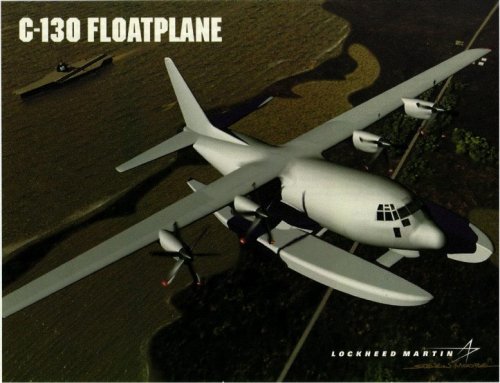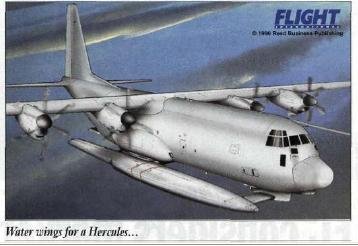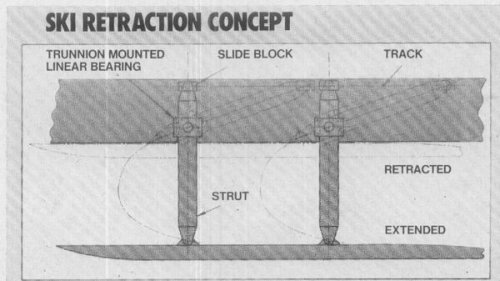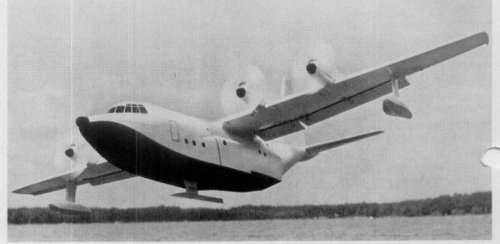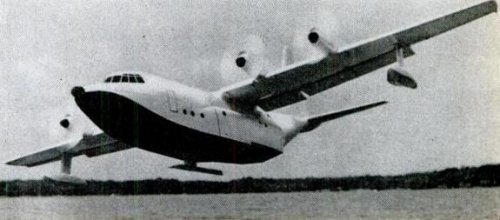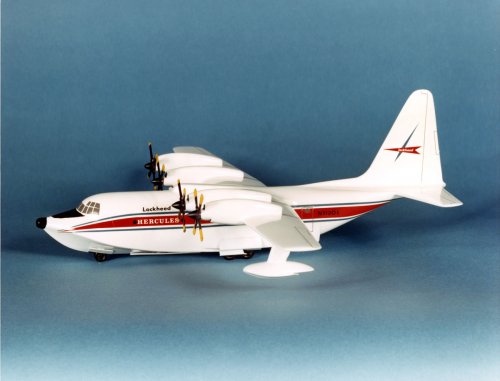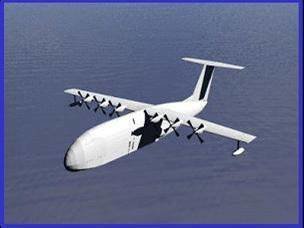You are using an out of date browser. It may not display this or other websites correctly.
You should upgrade or use an alternative browser.
You should upgrade or use an alternative browser.
Lockheed C-130 Hercules Seaplane/Amphibious Versions
- Thread starter CammNut
- Start date
- Joined
- 26 May 2006
- Messages
- 34,869
- Reaction score
- 15,733
Attachments
- Joined
- 11 March 2006
- Messages
- 8,624
- Reaction score
- 3,792
Not the only attempt, to make the good old Herc swim :
A dedicated planing bottom with an additional hydroski,
auxiliary floats at the wings and the engines mounted
above the wing.
(from FlugRevue 1/1975)
A dedicated planing bottom with an additional hydroski,
auxiliary floats at the wings and the engines mounted
above the wing.
(from FlugRevue 1/1975)
Attachments
Artist's concept of Lockheed-Georgia L-100 Hercules amphibian intended as a short-takeoff-and-landing airliner between major cities. Engines are atop the wings and a retractable hydro-ski is under the fiberglass hull.
Source: "STOL amphibian" Popular Science October 1973 page 93
model photo
Source : http://www.whatifmodelers.com/index.php/topic,455.msg242328.html#msg242328]Source: [url=http://www.whatifmodelers.com/index.php/topic,455.msg242328.html#msg242328]http://www.whatifmodelers.com/index.php/topic,455.msg242328.html#msg242328[/url]
Source: "STOL amphibian" Popular Science October 1973 page 93
model photo
Source : http://www.whatifmodelers.com/index.php/topic,455.msg242328.html#msg242328]Source: [url=http://www.whatifmodelers.com/index.php/topic,455.msg242328.html#msg242328]http://www.whatifmodelers.com/index.php/topic,455.msg242328.html#msg242328[/url]
Attachments
McColm said:Hi there,
Lockheed developed a "float plane" convertion kit known as the CL-130 for the Herk to land on water. They tested their design on a third scale model and found that the payload and range was cut by 30% due to the weight and drag.
The C-130J has improved range and payload. If a one-step hull was bolted on to the fuselage with mid sponsors the engines would be raised high enough so that no floats would be deployed. A podded jet engine on each wing would give the Herk the extra boost on takeoff.
The hull could be designed to scoop fresh water from lakes as a water bomber or be deployed by the Navy or Coast Guard in Search & Rescue missions. Even the option of a commercial airline might make this idea seem viable.
Has this idea been tested?
Back in the 1960's Lockheed initiated a project called HOW Hercules on water. Some of this engineering was later incorporated into the YMC-130 Credible Sport C-130 and the HTTB. High Technology testbed.
Enjoy the drawings. The final 2 drawings are in 1/72nd scale of the wing and fuselage modifications.
Enjoy.
Batman







































- Joined
- 30 November 2007
- Messages
- 1,126
- Reaction score
- 586
Dear Boys and Girls, here is a picture with a caption in French of a flying model used to test Lockheed's Hercules HOW design (Moderators; should I have put this in "post-war projects" instead?)......
The picture comes from the 1st & 15th June 1968 issue of Aviation Magazine International......
Terry (Caravellarella)
The picture comes from the 1st & 15th June 1968 issue of Aviation Magazine International......
Terry (Caravellarella)
Attachments
- Joined
- 27 December 2005
- Messages
- 17,742
- Reaction score
- 26,323
C-130 HOW (Hercules On Water)
http://www.codeonemagazine.com/gallery_slideshow.html?item_id=2098Between 1964 and 1973, Lockheed-Georgia Company looked at several amphibious configurations of the C-130 Hercules. In 1968, a US Navy study contract resulted in a one-sixth scale, radio controlled model that was used as a development tool. Called Hercules-On-Water, or HOW, the design kept much of the original C-130 configuration, but this version used a retractable hydro-ski beneath the boat hull-shaped fuselage for takeoff and landing. The design’s Allison T56 engines were inverted and placed on top of the wing to take the intakes and propellers out of the water spray, similar to the configuration used on the P-3 Orion maritime patrol aircraft. No production contracts were received and the Hercules-On-Water project was shelved.
Attachments
- Joined
- 26 May 2006
- Messages
- 34,869
- Reaction score
- 15,733
Attachments
- Joined
- 27 March 2006
- Messages
- 1,870
- Reaction score
- 1,617
The following posts...
Page 1 Reply 13
Page 2 Reply 26 and 28
Page 4 Reply 45 and 49
Page 5 reply 74
...all deal with that Hercules amphibian project with plane below the fuselage, but going through the topic, I noticed that there isn't a 3 view, which I have attached below.
I can't unfortunately recall where I got the image from, but it is mostly identical in features with the previously posted artwork, with only minor differences in cockpit glazing, nose radar, and the top shape of the vertical stabiliser. The big difference I can see is what appears to be a type of LERX adjoining the tailplane/horizontal stabiliser.
Page 1 Reply 13
Page 2 Reply 26 and 28
Page 4 Reply 45 and 49
Page 5 reply 74
...all deal with that Hercules amphibian project with plane below the fuselage, but going through the topic, I noticed that there isn't a 3 view, which I have attached below.
I can't unfortunately recall where I got the image from, but it is mostly identical in features with the previously posted artwork, with only minor differences in cockpit glazing, nose radar, and the top shape of the vertical stabiliser. The big difference I can see is what appears to be a type of LERX adjoining the tailplane/horizontal stabiliser.
Attachments
- Joined
- 25 June 2009
- Messages
- 14,749
- Reaction score
- 6,112
kaiserbill said:The following posts...all deal with that Hercules amphibian project with plane below the fuselage, but going through the topic, I noticed that there isn't a 3 view, which I have attached below.
Possibly because we already have a separate topic dedicated to the amphibian Hercules?
- Joined
- 27 March 2006
- Messages
- 1,870
- Reaction score
- 1,617
I used the search function, but it didn't crop up. What did crop up was this thread, which has been merged with another similar one already.
Doing another search after reading that using combinations of "amphibious", "amphibian", "Hercules" and "C-130" still does nothing for me.
Do you have a link?
Doing another search after reading that using combinations of "amphibious", "amphibian", "Hercules" and "C-130" still does nothing for me.
Do you have a link?
- Joined
- 6 November 2010
- Messages
- 5,261
- Reaction score
- 5,503
My search for 'Hercules on water' gave this:
http://www.secretprojects.co.uk/forum/index.php/topic,7197.msg62263.html#msg62263
Not that easy to find, I must say. Most of the forum's content about the amphibious Hercules is to be found in this 'C-130 Hercules Projects' thread anyway.
Topics merged
http://www.secretprojects.co.uk/forum/index.php/topic,7197.msg62263.html#msg62263
Not that easy to find, I must say. Most of the forum's content about the amphibious Hercules is to be found in this 'C-130 Hercules Projects' thread anyway.
Topics merged
- Joined
- 25 June 2009
- Messages
- 14,749
- Reaction score
- 6,112
I'm questioning the relevance of merging the topics here, especially when it creates a long topic like this.
It seemed appropriate enough to distinguish between the water-based proposals and the land-based ones.
It seemed appropriate enough to distinguish between the water-based proposals and the land-based ones.
- Joined
- 27 March 2006
- Messages
- 1,870
- Reaction score
- 1,617
Thanks Arjen.
Quite comprehensive.
I see why I couldn't find it...it's under Hercules VSTOL. I also didn't search for "Hercules on water" not knowing it's designation.
Plus, I could perhaps have shown more resilience when searching... ;D
Skyblazer, thanks. Quite agree, especially seeing the exceptionally long service and production lifetime of the Hercules, and the incredible amount of variants/concepts that longevity has spawned. There must be a record in there surely.
Quite comprehensive.
I see why I couldn't find it...it's under Hercules VSTOL. I also didn't search for "Hercules on water" not knowing it's designation.
Plus, I could perhaps have shown more resilience when searching... ;D
Skyblazer, thanks. Quite agree, especially seeing the exceptionally long service and production lifetime of the Hercules, and the incredible amount of variants/concepts that longevity has spawned. There must be a record in there surely.
- Joined
- 11 March 2006
- Messages
- 8,624
- Reaction score
- 3,792
Many thanks kaiserbill for shouldering the effort to locate those posts exactly. Have split them and
merged to this topic now. Our C-130 threads need some tidying up either and that was a great
support.
The pictures in the "C-130 V/STOL" thread really were well hidden ! : If you find something like that,
If you find something like that,
you can either make a post or just send a PM. And again, if you can precisely point to the relevant posts,
it's much better, of course, than saying "...there already was a similar thread", as this is somehow as
saying "Where's the bone ?" to your dog.
merged to this topic now. Our C-130 threads need some tidying up either and that was a great
support.
The pictures in the "C-130 V/STOL" thread really were well hidden ! :
you can either make a post or just send a PM. And again, if you can precisely point to the relevant posts,
it's much better, of course, than saying "...there already was a similar thread", as this is somehow as
saying "Where's the bone ?" to your dog.
- Joined
- 25 June 2009
- Messages
- 14,749
- Reaction score
- 6,112
Jemiba said:it's much better, of course, than saying "...there already was a similar thread", as this is somehow as saying "Where's the bone ?" to your dog.
What you seem to interpret as simple laziness on my part was rather a call to dig a little deeper, instead of waiting for someone to bring it to you everything on a silver platter (not saying that's what happened here, just that it's often what happens in general). This being said, I wasn't aware that the amphibious Hercules topic would be so difficult to locate!
- Joined
- 9 October 2009
- Messages
- 21,944
- Reaction score
- 13,576
I sometimes suspect that our search engine has become self-aware and delights in tormenting and frustrating us!
- Joined
- 25 June 2009
- Messages
- 14,749
- Reaction score
- 6,112
Grey Havoc said:I sometimes suspect that our search engine has become self-aware and delights in tormenting and frustrating us!
Ha ha!! That sure would explain a lot! ;D
- Joined
- 6 November 2010
- Messages
- 5,261
- Reaction score
- 5,503
I started with a straightforward search for Hercules Amphibian, which pointed me to the C-130 Projects thread and not much else. Then I scrolled through the Projects thread, came across Hercules On Water - another dead end end really. Strangely enough, arranging the search terms differently did the trick - after scrolling to result #10 or thereabouts.
It's there, it can be found, but sometimes an external (Ixquick, Startpage, Google, whatever) search on SPF does better. If you aren't sure there's anything to be found at all, things can stay well hidden in Write-Only-Memory.
It's there, it can be found, but sometimes an external (Ixquick, Startpage, Google, whatever) search on SPF does better. If you aren't sure there's anything to be found at all, things can stay well hidden in Write-Only-Memory.
Old thread, new request...can anyone point me to any original source documents or media reports on proposed *floatplane* conversions of the C-130 rather than the much more elaborate boat-hull amphibian conversion discussed in most of this thread? I saw in another thread a reference to a a float conversion resulting in a 30% reduction in range and payload based on model tests. I would really like to find the source of that information. Thanks!
- Joined
- 17 October 2006
- Messages
- 2,393
- Reaction score
- 1,196
CluttonFred.... From IDR 2/98.
In another one-of-a-kind effort, Lockheed Martin is still working on one of the strangest C-130 derivatives yet: a floatplane version, under study since 1996. A small contract is supporting wind-tunnel and water tank tests.
The initial interest in this version came from the Navy SEAL (Sea, Air, Land) special-operations force, because of its potential to deliver SEAL teams in small watercraft to off-shore drop-off points, and recover them complete with their equipment.
The current concept features two 21 m pontoons, joined by faired struts which are attached to the C-130’s nose and main landing gear mounts. The estimated weight of the floats is 5900 kg and their drag is significant, but the better performance of the C-130J makes the modification more attractive: a C-130J with floats can carry a 9 t payload on a 2700 km un-refuelled mission, which exceeds the performance of any other runway-free vehicle. The floatplane can carry many SEAL craft, including swimmer delivery vehicles on launching pallets. Lockheed is confident that the aircraft will be able to operate in Sea State 2 and is aiming for Sea State 3 (2 m swells).
Lockheed Martin estimates that the floatplane could be built and tested in a 2.5-year program for about $20 million, and that a set of floats would cost about $7.5 million.
In another one-of-a-kind effort, Lockheed Martin is still working on one of the strangest C-130 derivatives yet: a floatplane version, under study since 1996. A small contract is supporting wind-tunnel and water tank tests.
The initial interest in this version came from the Navy SEAL (Sea, Air, Land) special-operations force, because of its potential to deliver SEAL teams in small watercraft to off-shore drop-off points, and recover them complete with their equipment.
The current concept features two 21 m pontoons, joined by faired struts which are attached to the C-130’s nose and main landing gear mounts. The estimated weight of the floats is 5900 kg and their drag is significant, but the better performance of the C-130J makes the modification more attractive: a C-130J with floats can carry a 9 t payload on a 2700 km un-refuelled mission, which exceeds the performance of any other runway-free vehicle. The floatplane can carry many SEAL craft, including swimmer delivery vehicles on launching pallets. Lockheed is confident that the aircraft will be able to operate in Sea State 2 and is aiming for Sea State 3 (2 m swells).
Lockheed Martin estimates that the floatplane could be built and tested in a 2.5-year program for about $20 million, and that a set of floats would cost about $7.5 million.
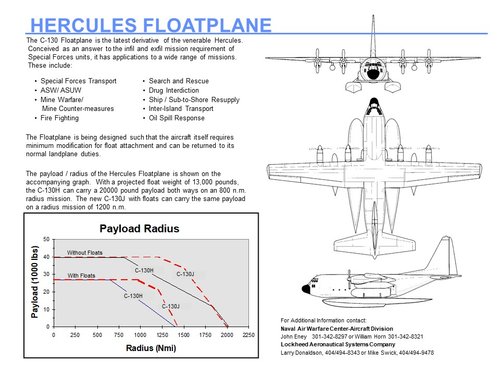
- Joined
- 19 July 2016
- Messages
- 4,270
- Reaction score
- 3,454
Give them time, and a flux capacitor..........
taildragger
You can count on me - I won a contest
- Joined
- 2 November 2008
- Messages
- 404
- Reaction score
- 502
Interesting that the wing-mounted external tanks are retained. The floats have plenty of volume for fuel and I'd think that placing the tanks inside them could make refueling on the water easier.CluttonFred.... From IDR 2/98.
In another one-of-a-kind effort, Lockheed Martin is still working on one of the strangest C-130 derivatives yet: a floatplane version, under study since 1996. A small contract is supporting wind-tunnel and water tank tests.
The initial interest in this version came from the Navy SEAL (Sea, Air, Land) special-operations force, because of its potential to deliver SEAL teams in small watercraft to off-shore drop-off points, and recover them complete with their equipment.
The current concept features two 21 m pontoons, joined by faired struts which are attached to the C-130’s nose and main landing gear mounts. The estimated weight of the floats is 5900 kg and their drag is significant, but the better performance of the C-130J makes the modification more attractive: a C-130J with floats can carry a 9 t payload on a 2700 km un-refuelled mission, which exceeds the performance of any other runway-free vehicle. The floatplane can carry many SEAL craft, including swimmer delivery vehicles on launching pallets. Lockheed is confident that the aircraft will be able to operate in Sea State 2 and is aiming for Sea State 3 (2 m swells).
Lockheed Martin estimates that the floatplane could be built and tested in a 2.5-year program for about $20 million, and that a set of floats would cost about $7.5 million.View attachment 633578
One possibility is that the floats are intended to be easily installed/removed so that the aircraft wouldn't be a full time seaplane. The post's mention of the floats attaching to the landing gear mounts (suggesting that the landing gear is removed) and the awkwardness of attaching/removing 21m floats suggest that this would not be a temporary conversion. Even if temporary conversion is intended, attaching/removing the external wing tanks would seem like a minor task compared to doing the same with the floats and landing gear.
My guess is that the drag reduction achieved would not be the cost of redesigning the fuel system.
It could also be that floats are viewed as a at high risk of damage (hitting floating objects for instance) and that locating fuel tanks there could make a bad accident worse.
I wonder what the tradeoffs are between the floatplane scheme and earlier proposals to add a seaplane hull to the fuselage.
Last edited:
- Joined
- 17 October 2006
- Messages
- 2,393
- Reaction score
- 1,196
That's the H model, which really needed the external tanks. Later, the floatplane was proposed as a J derivative (once the J itself was delivered).
One reason given in favor of floats versus a boat hull was that you could make full use of the rear ramp.
One reason given in favor of floats versus a boat hull was that you could make full use of the rear ramp.
- Joined
- 11 March 2012
- Messages
- 3,247
- Reaction score
- 3,176
Given that mainland China is investing heavily in 4-engined flying-boats to serve the "new islands" in the South China Sea, it makes sense for the USA to develop long-range seaplanes too. Bolting pontoons onto a C-130 sounds like the quickest conversion.
Only a few of these "new islands" are long enough for conventional runways.
Only a few of these "new islands" are long enough for conventional runways.
- Joined
- 9 October 2009
- Messages
- 21,944
- Reaction score
- 13,576
As a short term expedient yes. For the longer term better to go with a clean sheet design or relatively so.
royabulgaf
ACCESS: Top Secret
- Joined
- 29 December 2008
- Messages
- 678
- Reaction score
- 349
Given that mainland China is investing heavily in 4-engined flying-boats to serve the "new islands" in the South China Sea, it makes sense for the USA to develop long-range seaplanes too. Just because China develops something to suit its military needs, it doesn't mean we must also. If you can show a real military need, by all means proceed. The Shin Miewa US-2 is in production. We could buy a couple squadrons worth, maybe trading off F-35 prodjuction to pay for it.
- Joined
- 17 October 2006
- Messages
- 2,393
- Reaction score
- 1,196
ONR did some seaplane studies circa 2005 in support of sea-basing concepts. This particular aircraft was designed to haul 30 tons at 325 kt for 2000 nm - the design may have been out of MIT. Six engines eased the engine-out case and provided blowing over more of the wing span.
BTW AG600 handily out-ranges and out-hauls the Osprey. The aircraft and missions are not comparable at all.
BTW AG600 handily out-ranges and out-hauls the Osprey. The aircraft and missions are not comparable at all.
Attachments
- Joined
- 21 May 2006
- Messages
- 3,002
- Reaction score
- 2,270
I must say, how much sense does a C-130 flyingboat make!!Artist's concept of Lockheed-Georgia L-100 Hercules amphibian intended as a short-takeoff-and-landing airliner between major cities. Engines are atop the wings and a retractable hydro-ski is under the fiberglass hull.
Source: "STOL amphibian" Popular Science October 1973 page 93
model photo
Source : http://www.whatifmodelers.com/index.php/topic,455.msg242328.html#msg242328]Source: [url=http://www.whatifmodelers.com/index.php/topic,455.msg242328.html#msg242328]http://www.whatifmodelers.com/index.php/topic,455.msg242328.html#msg242328[/url]
Regards
Pioneer
I must say, how much sense does a C-130 flyingboat make!!
A flying boat... sure, that might make some sense. But the floatplane versions seem somewhat less sensible. The C-130 is a cargo plane, after all, and a floatplane puts the cargo up rather high, making it somewhat difficult to load and remove. Granted, the floatplane version shown here isn't *really* high, but it's still added difficulty.
That said: if the floatplane version is a swappable design where the floats can be added or removed relatively quickly and easily, then this would seem to be a magnificent fire fighting plane, able to quickly tank up from nearby rivers and lakes.
- Joined
- 17 October 2006
- Messages
- 2,393
- Reaction score
- 1,196
OBB - The original idea behind the floatplane was that the rear ramp could be opened on the water. If you had a flying boat with a rear ramp, opening it while afloat could have deleterious consequences.
If you had a flying boat with a rear ramp, opening it while afloat could have deleterious consequences.
*Perhaps.* There are relevant precedents:

Of course, pulling that stunt off with an aircraft capable of horsing itself back up into the air is left as an exercise for the student.
- Joined
- 5 May 2007
- Messages
- 1,481
- Reaction score
- 2,855
The Chinook can do it. On the other hand, it keeps itself airborne by sheer horsepower augmented by ugliness.Of course, pulling that stunt off with an aircraft capable of horsing itself back up into the air is left as an exercise for the student.
The Chinook can do it. On the other hand, it keeps itself airborne by sheer horsepower augmented by ugliness.
I think the water simply rejects the Chinook. "Eww, eww, get off me. GET OFF ME! MOM!!!! STOP TOUCHING ME!!"
Weird thing about aircraft: the best ones are either the truly beautiful ones, like the P-51 or the SR-71, or the downright fugly ones like the Chinook and the A-10.
Counterpoint: fugly pre-war French aircraft.
Hank58
ACCESS: Restricted
- Joined
- 9 June 2020
- Messages
- 40
- Reaction score
- 162
Lockheed used to call those root leading-edge extensions ahead of the tailplane "horsals", a mash-up of "horizontal" and "dorsal". They functions in the pitch axis like the dorsal fin ahead of the vertical fin and rudder does in the yaw axis.The following posts...
Page 1 Reply 13
Page 2 Reply 26 and 28
Page 4 Reply 45 and 49
Page 5 reply 74
...all deal with that Hercules amphibian project with plane below the fuselage, but going through the topic, I noticed that there isn't a 3 view, which I have attached below.
I can't unfortunately recall where I got the image from, but it is mostly identical in features with the previously posted artwork, with only minor differences in cockpit glazing, nose radar, and the top shape of the vertical stabiliser. The big difference I can see is what appears to be a type of LERX adjoining the tailplane/horizontal stabiliser.
Also, through an odd series of events I ended up with two approximately four-foot long "tow tank" (the aquatic analog to a wind tunnel) hull models (with that centerline hydro-ski feature) that were fabricated, but never tested before the C-130 amphibian project died. They are stashed in my basement. I'll have to dig them out and take some photos. I believe, if memory serves me right, that they feature two slightly different hull step configurations. But, it's been maybe about 30 years since I looked at them.
shin_getter
ACCESS: Top Secret
- Joined
- 1 June 2019
- Messages
- 1,102
- Reaction score
- 1,482

It Looks Like A C-130 Seaplane Is Finally Happening
Air Force Special Operations Command says it needs an MC-130J on floats and it looks like it has a plan to get it.
In partnership with the Air Force Research Lab's Strategic Development Planning and Experimentation (AFRL-SDPE) directorate, AFSOC is developing an MC-130J Commando II Amphibious Capability (MAC) to improve the platform's support of seaborne special operations. "The development of the MAC capability is the culmination of multiple lines of effort," said Lt Col Josh Trantham, AFSOC Science, Systems, Technology, & Innovation (SST&I) Deputy Division Chief. "This capability allows the Air Force to increase placement and access for infiltration, exfiltration, and personnel recovery, as well as providing enhanced logistical capabilities for future competition and conflict."
Here we go again?
Similar threads
-
-
USAF SOR-187: VTOL search and rescue aircraft
- Started by overscan (PaulMM)
- Replies: 6
-
XC-Medium - Alternatives to the Lockheed C-130 Hercules?
- Started by Pioneer
- Replies: 53
-
Advanced Medium STOL Transport (AMST) and its predecessors
- Started by Pioneer
- Replies: 229
-
Vought V-3010 Sealifter: Extreme STOL Amphibious Transport
- Started by Stargazer
- Replies: 1

